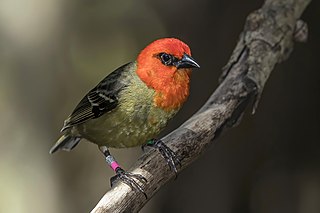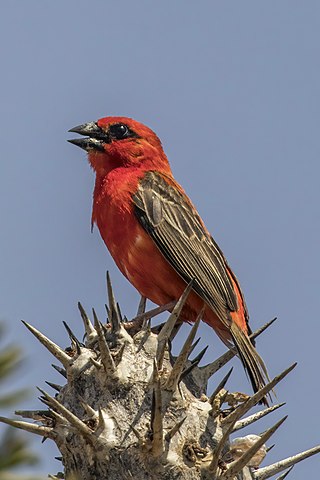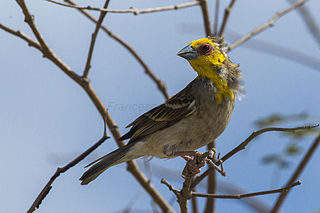
The cuckoo-roller or courol is the only bird in the family Leptosomidae, which was previously often placed in the order Coraciiformes but is now placed in its own order Leptosomiformes. The cuckoo-roller is at the root of a group that contains the Trogoniformes, Bucerotiformes, Piciformes, and Coraciiformes. Despite its name, the Cuckoo-roller does not share close evolutionary origins with cuckoos or rollers at all.

The Mauritius fody is a rare species of bird in the weaver family. It is endemic to the island of Mauritius. It is classified by BirdLife International as being endangered. It is also on the United States' Endangered Species List with an endangered status.

The lesser vasa parrot or black parrot is a black coloured parrot endemic to most of Madagascar. It is one of four species of vasa parrots, the others being the greater vasa parrot, the Seychelles black parrot, and the Comoros black parrot. The latter two were formerly considered conspecific with the lesser vasa parrot.

The Seychelles fody is a small yellowish songbird that are native to the Seychelles islands of Cousin Island, Cousine Island, Frégate Island, and have been introduced to Aride Island, D'Arros Island and as of 2004 Denis Island. Their natural habitat is woodland, but they have adapted to living in such habitats as coconut plantations and gardens.

The red fody, also known as the Madagascar fody in Madagascar, red cardinal fody in Mauritius, or common fody, is a small bird native to Madagascar and introduced to various other islands in the Indian Ocean. It is a common bird within its restricted range, and the International Union for Conservation of Nature has assessed its conservation status as being of "least concern".

Fodies are small passerine birds belonging to the genus Foudia in the weaver family Ploceidae.

The Malagasy turtle dove is a bird species in the pigeon and dove family, Columbidae. It is found in Mauritian-Indian Ocean Territory, the Comoros, Madagascar, Mauritius, Mayotte, Réunion, and the Seychelles.

The Rodrigues fody is a rare species of bird in the weaver family. It is endemic to Rodrigues, an island of Mauritius. It is classified by BirdLife International as being vulnerable. It is also on the United States' Endangered Species List with an endangered status.

The forest fody is a species of bird in the family Ploceidae. It is endemic to Madagascar.

Humblot's sunbird is a species of bird in the family Nectariniidae. It is endemic to the islands of Grand Comoro and Mohéli in the Comoros.

The Malagasy green sunbird, also known as the long-billed green sunbird, is a species of bird in the family Nectariniidae. It has been placed in the genus Nectarinia. It is found in the Comoros and Madagascar. Its natural habitats are subtropical or tropical dry forest, subtropical or tropical moist lowland forest, subtropical or tropical mangrove forest, and subtropical or tropical moist montane forest.

The nelicourvi weaver is a species of bird in the family Ploceidae. It is endemic to Madagascar. Together with its closest relative, the sakalava weaver, it is sometimes placed in a separate genus Nelicurvius. A slender, sparrow-like bird, it is 15 cm (5.9 in) long and weighing 20–28 g (0.71–0.99 oz). Breeding males have a black bill and head, brown eyes, yellow collar, grey belly, chestnut-brown lower tail coverts, olive back, and blackish flight feathers edged greenish. Non-breeding males have mottled grey and green heads. In the breeding female the front of the head is yellow and the back olive green, with a broad yellow eyebrow. It builds solitary, roofed, retort-shaped nests, hanging by a rope from a branch, vine or bamboo stem, in an open space. It primarily feeds on insects, looking on its own or in very small groups, often together with long-billed bernieria. Its natural habitat is subtropical or tropical moist lowland and mountain forests. The conservation status of Nelicourvi weaver is least concern according to the IUCN Red List.

The Sakalava weaver sometimes known as the Sakalava fody is a species of bird in the family Ploceidae. It is endemic to Madagascar. The bird is 15 cm (5.9 in) long and weighs 20–28 g (0.71–0.99 oz).

The Mayotte white-eye or chestnut-sided white-eye is a species of bird in the family Zosteropidae. It is now found only on Mayotte in the Comoro Islands. Its natural habitats are subtropical or tropical dry forests, subtropical or tropical moist lowland forests, and subtropical or tropical mangrove forests.
The Réunion fody is an extinct bird species from the family of weavers. It was endemic to the Mascarene island of Réunion.

Pointes et plages de Saziley et Charifou is a protected area in Mayotte, a French island territory in the Comoro archipelago of the western Indian Ocean. It was established in 1997.

The Aldabra fody is a passerine bird in the family Ploceidae. It is endemic to Aldabra Island in the Indian Ocean.
Analavelona, also known as Analavelona Massif, is a mountain in southwestern Madagascar. The massif is home to an enclave of montane subhumid forest, which is considered a sacred forest by the local people and notable for its biodiversity.

















